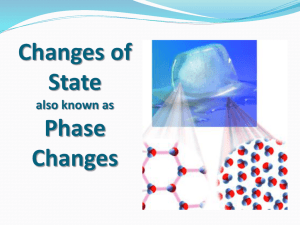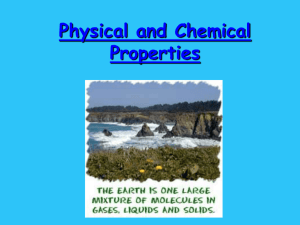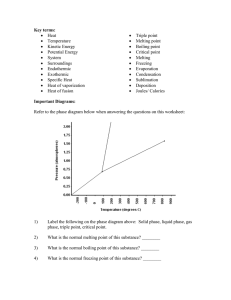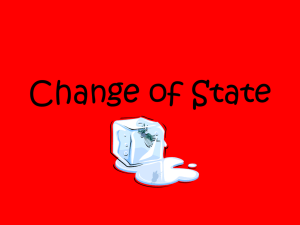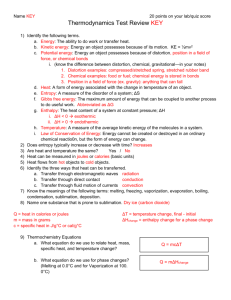2. Matter and Energy
advertisement
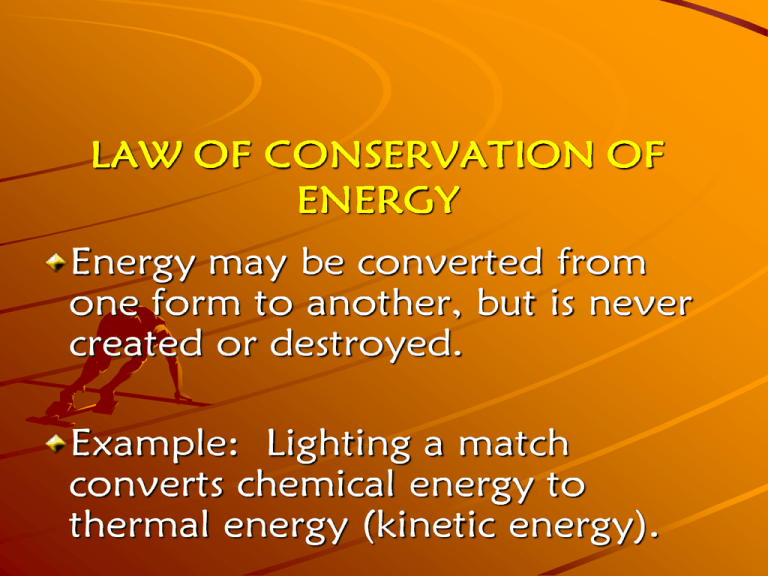
Physical States of Matter Solid (s) Liquid (l) Gas (g) Aqueous (aq) *must know how to define them using shape and volume. Techniques for Separating Mixtures Filtration Distillation Magnet EXOTHERMIC: energy is given off in a chemical reaction. A+B C + Heat ENDOTHERMIC: energy is absorbed in a chemical reaction. Heat + A B+C Entropy: A measure of the disorder of a system. The more disorder, the more entropy. Potential Energy (PE): Stored energy. Kinetic Energy (KE): Energy of movement. Energy is transferred from one form to another. Potential Energy Kinetic Energy Heat Flow Whenever two objects with different temps are in contact, heat travels from higher temperature to lower temperature until both temps are the same If you have a cup of milk at 80°C and a cup at 20°C and you mix the two cups together, heat would flow from the cup of milk at 80°C to the cup of milk at 20°C until both cups are at the same temp, around 50°C REMEMBER: To convert Kelvin to Celsius or Celsius to Kelvin use the following formula: K = °C + 273 Heating/Cooling Curve Endothermic/Exothermic (must be able to label the entire graph & label PE & KE changes) Heat Equations: (Table T) q = mC∆T q = mHf q = mHv q = Heat (in joules) m = Mass (in grams) C = Specific Heat Capacity (Table B): the amount of heat required to raise 1 gram of something 1 degree Celsius (ex: 4.18 joules/g°C) T = Change in temperature (Final - Initial) – If q is negative: exothermic reaction (release heat) – If q is positive: endothermic reaction (absorb heat) Hf = Heat of fusion (energy required to freeze/melt) Hv = Heat of vaporization (energy required to boil/condense) Table B represents physical constants for water only. If a heat equation question is asking about anything other than water, the constant for the substance will have to be provided (C, Hf,Hv). The plateau for vaporization/condensation is longer than melting/freezing because the Hv is greater than the Hf, and therefore it takes longer to add or release heat. 1. When 20.0g of a substance is completely melted at its melting point, 3444 J are absorbed. What is the heat of fusion of this substance? 2. The heat of vaporization of a liquid is 1344 J/g. What is the minimum number of joules needed to change 40.0g of the liquid to vapor at the boiling point? 3. How much energy is required to vaporize 10.00g of water at is boiling point? 4. At 1 atmosphere of pressure, 25.0g of a compound at its normal boiling point is converted to a gas by the addition of 34,400 J. What is the heat of vaporization for this compound in J/g? 5. The heat of fusion of a compound is 30.0 joules per gram. What is the number of joules of heat that must be absorbed by a 15.0g sample to change the compound from solid to liquid at its melting point?
